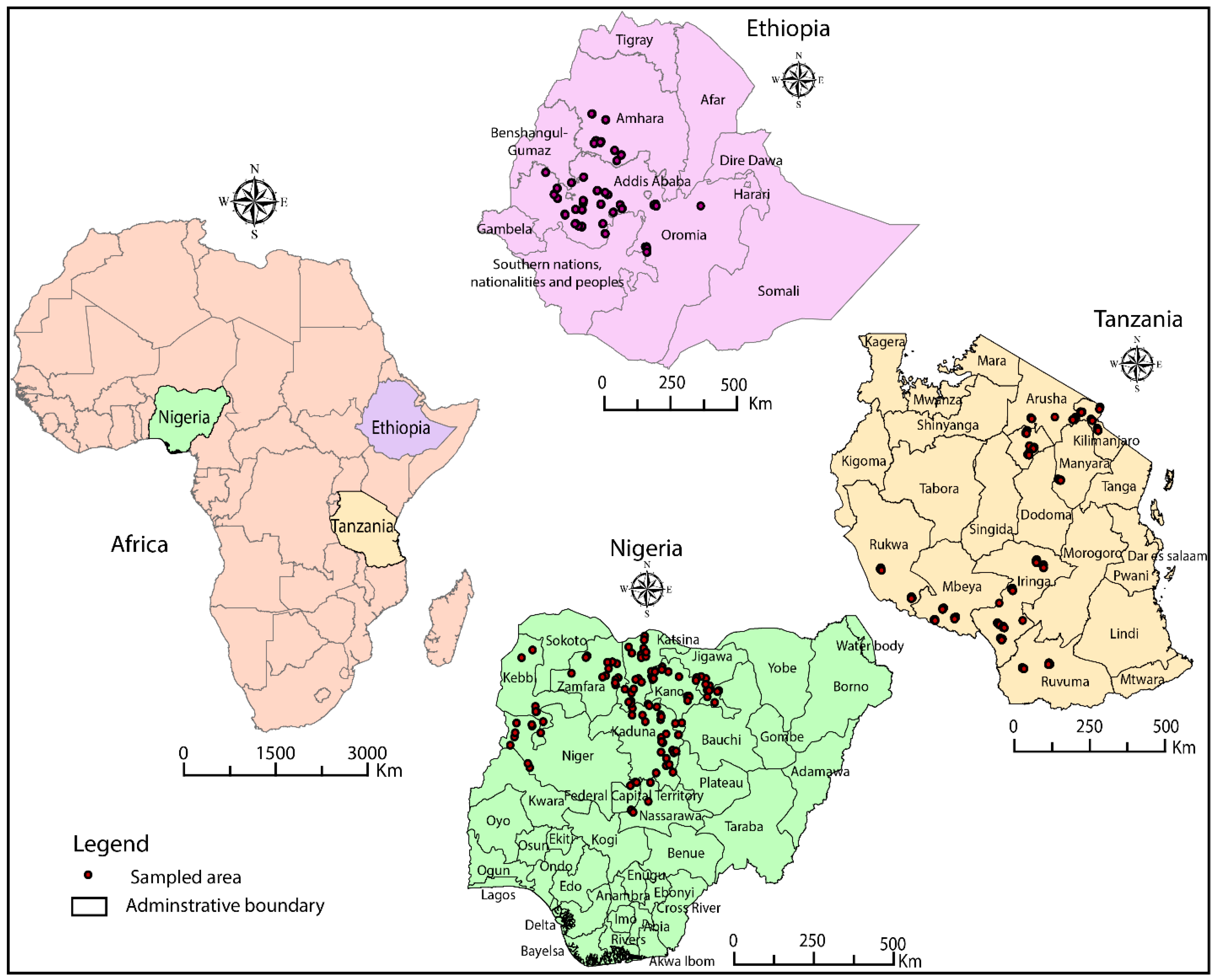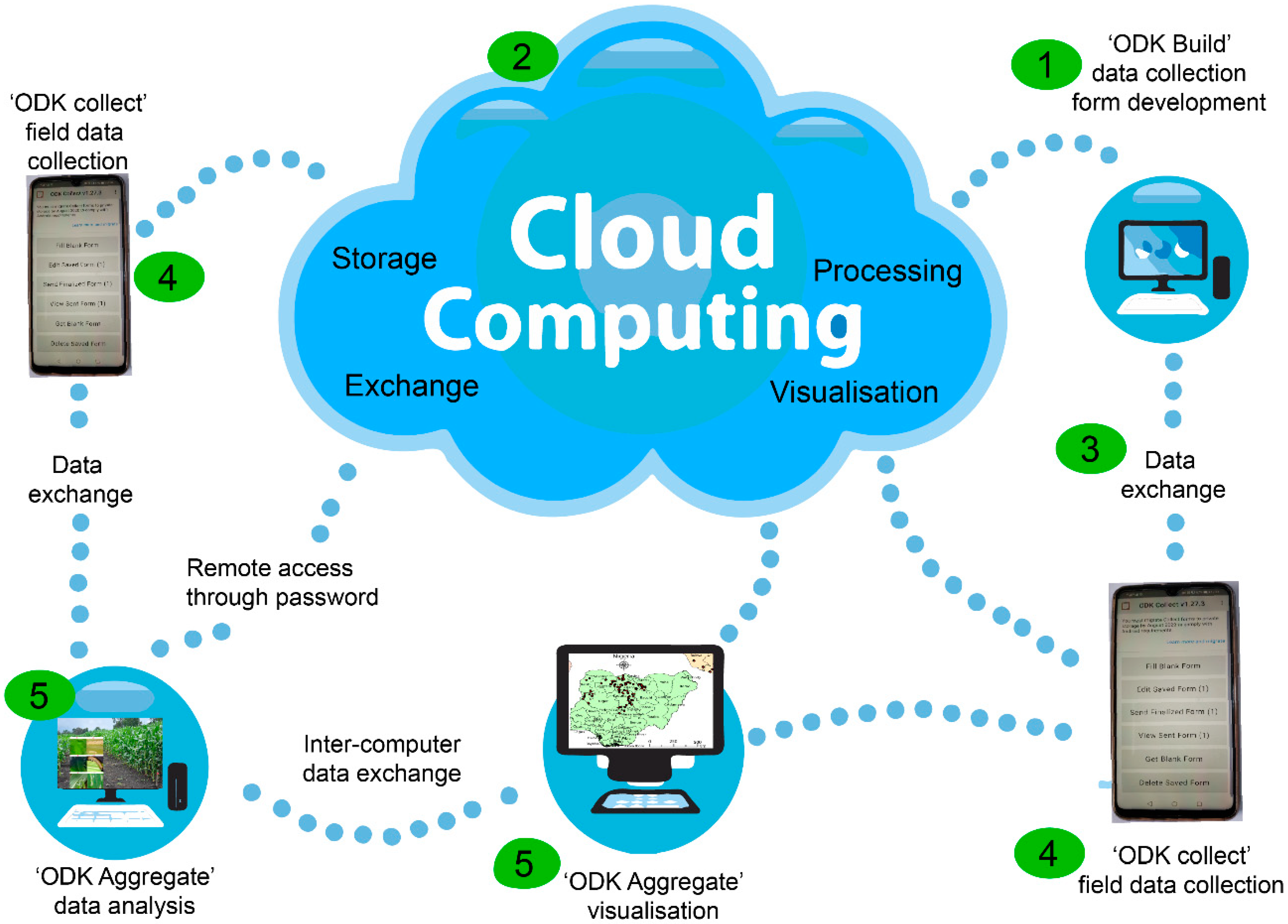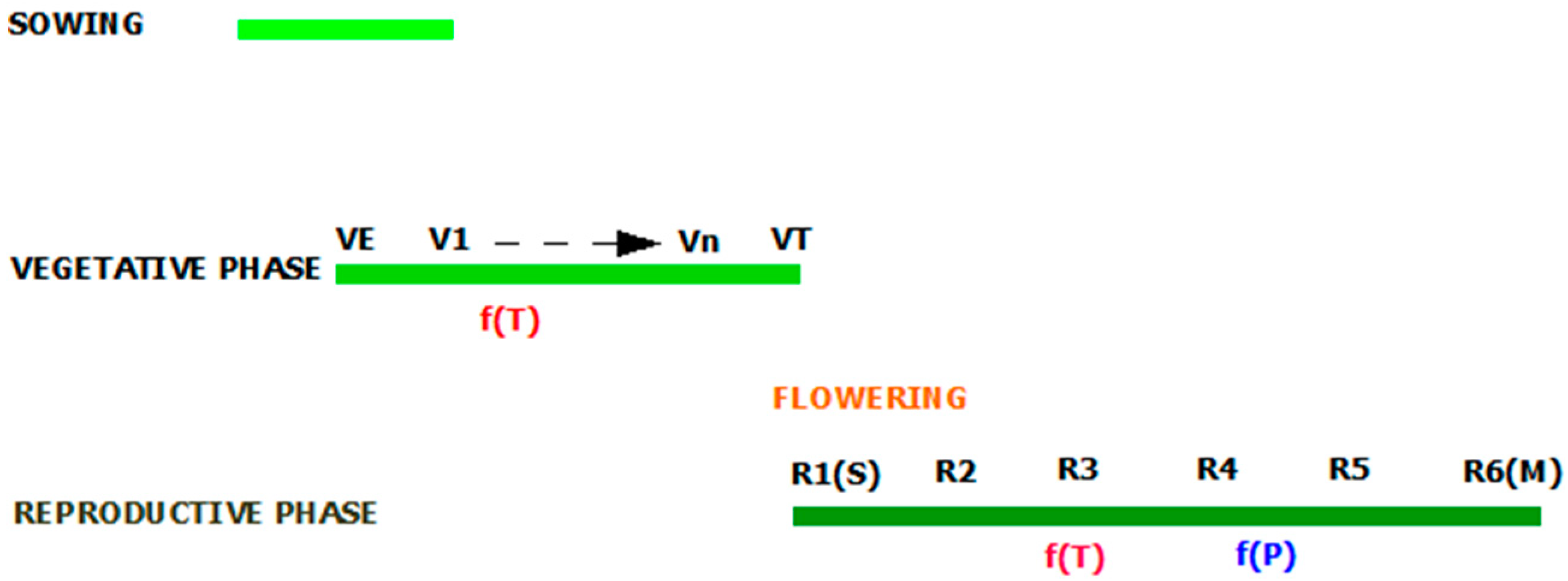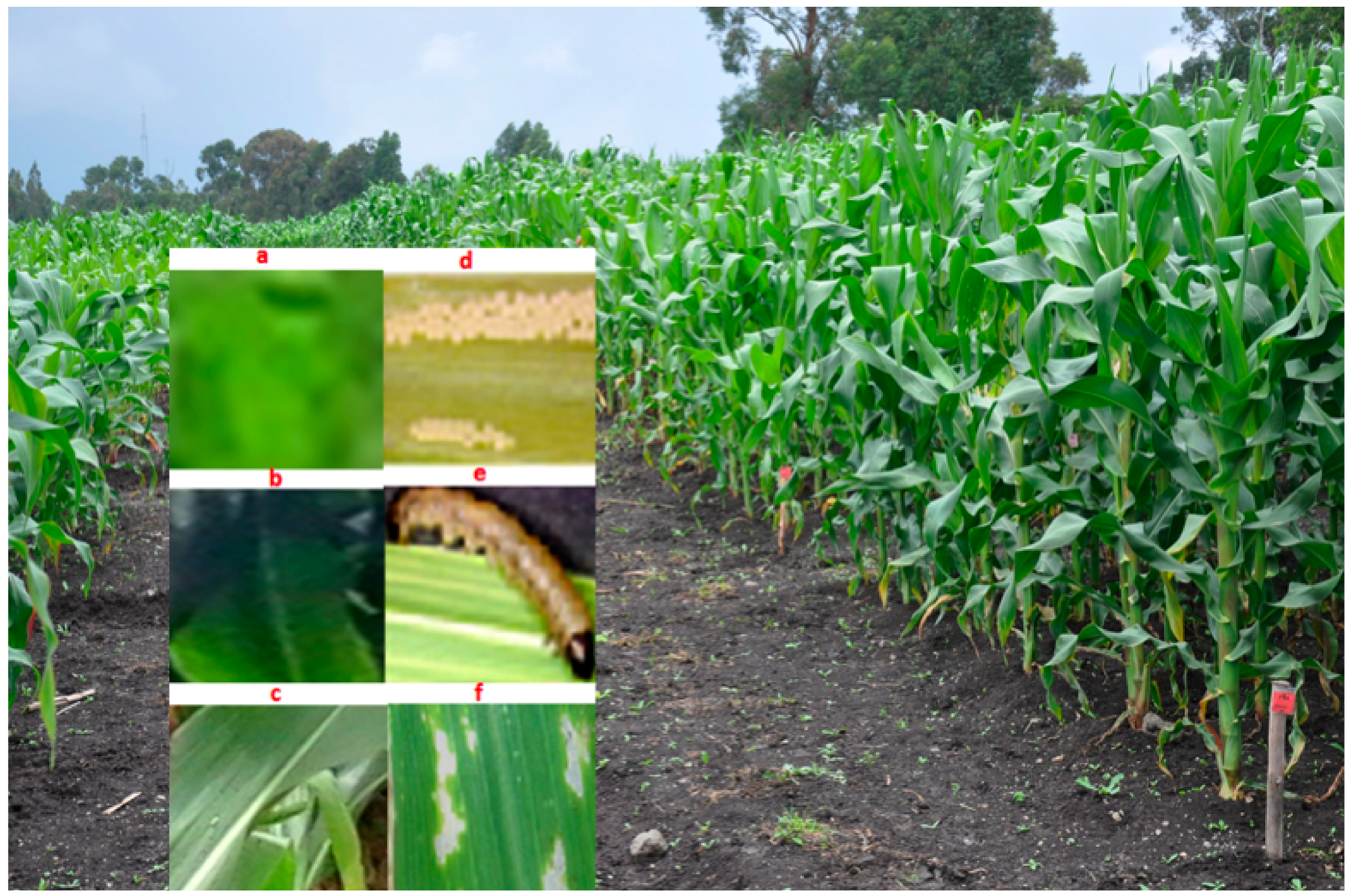Rapid Acquisition, Management, and Analysis of Spatial Maize (Zea mays L.) Phenological Data—Towards ‘Big Data’ for Agronomy Transformation in Africa
Abstract
1. Introduction
2. Materials and Methods
2.1. Study Areas
2.2. Experimental Design
2.3. Training Program of Data Collectors
2.4. Data Collection and Application Workflow
2.5. Maize Plant Phenology
2.6. The Accumulated Temperature during Growing Seasons
3. Results
3.1. Capabilities of the ODK Platform in Agriculture Research
3.2. Maize Phenology
4. Discussion
5. Conclusions
Supplementary Materials
Author Contributions
Funding
Conflicts of Interest
References
- Mendes, J.; Pinho, T.M.; Santos, F.; Sousa, J.J.; Peres, E.; Boaventura-Cunha, J.; Cunha, M.; Morais, R. Smartphone Applications Targeting Precision Agriculture Practices—A Systematic Review. Agronomy 2020, 10, 855. [Google Scholar] [CrossRef]
- Woodburn, M.; Ortmann, G.; Levin, J. Computer use and factors influencing computer adoption among commercial farmers in Natal Province, South Africa. Comput. Electron. Agric. 1994, 11, 183–194. [Google Scholar] [CrossRef]
- Ii, J.C.A.; Hoag, D.L.; Frasier, W.; McMaster, G.S. Computer use in agriculture: An analysis of Great Plains producers. Comput. Electron. Agric. 1999, 23, 189–204. [Google Scholar] [CrossRef]
- Zhang, N.; Wang, M.; Wang, N. Precision agriculture—A worldwide overview. Comput. Electron. Agric. 2002, 36, 113–132. [Google Scholar] [CrossRef]
- Sáiz-Rubio, V.; Rovira-Más, F. From Smart Farming towards Agriculture 5.0: A Review on Crop Data Management. Agronomy 2020, 10, 207. [Google Scholar] [CrossRef]
- Lichtfouse, E.; Navarrete, M.; Debaeke, P.; Souchere, V.; Alberola, C.; Menassieu, J. Agronomy for sustainable agriculture. A review. Agron. Sustain. Dev. 2009, 29, 1–6. [Google Scholar] [CrossRef]
- Reynolds, M.P.; Kropff, M.; Crossa, J.; Koo, J.; Kruseman, G.; Milan, A.M.; Rutkoski, J.; Schulthess, U.; Singh, B.; Sonder, K.; et al. Role of Modelling in International Crop Research: Overview and Some Case Studies. Agronomy 2018, 8, 291. [Google Scholar] [CrossRef]
- Booltink, H.; Van Alphen, B.; Batchelor, W.; Paz, J.; Stoorvogel, J.J.; Vargas, R. Tools for optimizing management of spatially-variable fields. Agric. Syst. 2001, 70, 445–476. [Google Scholar] [CrossRef]
- Tyndale-Biscoe, J.; Moore, G.; Western, A. A system for collecting spatially variable terrain data. Comput. Electron. Agric. 1998, 19, 113–128. [Google Scholar] [CrossRef]
- Shirima, K.; Mukasa, O.; Schellenberg, J.A.; Manzi, F.; John, D.; Mushi, A.; Mrisho, M.; Tanner, M.; Mshinda, H.M.; Schellenberg, D. The use of personal digital assistants for data entry at the point of collection in a large household survey in southern Tanzania. Emerg. Themes Epidemiol. 2007, 4, 5. [Google Scholar] [CrossRef]
- Kitchen, N.R. Emerging technologies for real-time and integrated agriculture decisions. Comput. Electron. Agric. 2008, 61, 1–3. [Google Scholar] [CrossRef]
- World Bank. World Development Report 2019: The Changing Nature of Work; World Bank: Washing, DC, USA, 2018; Volume 65. [Google Scholar]
- Tseng, C.-L.; Jiang, J.-A.; Lee, R.-G.; Lu, F.-M.; Ouyang, C.-S.; Chen, Y.-S.; Chang, C.-H. Feasibility study on application of GSM–SMS technology to field data acquisition. Comput. Electron. Agric. 2006, 53, 45–59. [Google Scholar] [CrossRef]
- Aziz, I.D.A.; Hasan, M.H.; Ismail, M.J.; Haron, N.S. Remote Monitoring in Agricultural Greenhouse Using Wireless Sensor and Short Message Service (SMS). Int. J. Eng. Technol. IJET 2009, 9, 1–12. [Google Scholar]
- Buckee, C.O.; Wesolowski, A.; Eagle, N.N.; Hansen, E.; Snow, R.W. Mobile phones and malaria: Modeling human and parasite travel. Travel Med. Infect. Dis. 2013, 11, 15–22. [Google Scholar] [CrossRef]
- Abraham, R. Mobile Phones and Economic Development: Evidence from the Fishing Industry in India. In Proceedings of the 2006 International Conference on Information and Communication Technologies and Development, Berkeley, CA, USA, 25–26 May 2006; Volume 4, pp. 48–56. [Google Scholar]
- Dillion, B. Using mobile phones to collect panel data in developing countries. J. Int. Dev. 2012, 24, 518–527. [Google Scholar] [CrossRef]
- Aker, J.C. Information from Markets Near and Far: Mobile Phones and Agricultural Markets in Niger. Am. Econ. J. Appl. Econ. 2010, 2, 46–59. [Google Scholar] [CrossRef]
- Chen, N.; Zhang, X.; Wang, C. Integrated open geospatial web service enabled cyber-physical information infrastructure for precision agriculture monitoring. Comput. Electron. Agric. 2015, 111, 78–91. [Google Scholar] [CrossRef]
- FAO; IFAD; UNICEF; WFP; WHO. The State of Food Security and Nutrition in the World 2019. Safeguarding Against Economic Slowdowns and Downturns. Rome; CC BY-NC-SA 3.0 IGO; FAO Licence: Rome, Italy, 2019.
- Mudereri, B.; Abdel-Rahman, E.M.; Dube, T.; Landmann, T.; Khan, Z.; Kimathi, E.; Owino, R.; Niassy, S. Multi-source spatial data-based invasion risk modeling of Striga (Striga asiatica) in Zimbabwe. GIScience Remote Sens. 2020, 57, 553–571. [Google Scholar] [CrossRef]
- Porter, J.R.; Semenov, M.A. Crop responses to climatic variation. Philos. Trans. R. Soc. B Boil. Sci. 2005, 360, 2021–2035. [Google Scholar] [CrossRef]
- Mudereri, B.T.; Dube, T.; Niassy, S.; Kimathi, E.; Landmann, T.; Khan, Z.R.; Abdel-Rahman, E.M. Is it possible to discern Striga weed (Striga hermonthica) infestation levels in maize agro-ecological systems using in-situ spectroscopy? Int. J. Appl. Earth Obs. Geoinf. 2020, 85, 102008. [Google Scholar] [CrossRef]
- International Food Policy Research Institute. Global Spatially-Disaggregated Crop Production Statistics Data for 2010 Version 2.0; Harvard Dataverse: Cambridge, MA, USA, 2019. [Google Scholar]
- Hartung, C.; Lerer, A.; Anokwa, Y.; Tseng, C.; Brunette, W.; Borriello, G. Open Data Kit: Tools to Build Information Services for Developing Regions. In Proceedings of the 4th ACM/IEEE International Conference on Information and Communication Technologies and Development, London, UK, 13–16 December 2010. [Google Scholar]
- Brunette, W.; Sundt, M.; Dell, N.; Chaudhri, R.; Breit, N.; Borriello, G. Open Data Kit 2.0: Expanding and Refining Information Services for Developing Regions. In Proceedings of the 14th Workshop on Mobile Computing Systems and Applications, Jekyll Island, GA, USA, 26–27 February 2013. [Google Scholar]
- Rossi, B.; Russo, B.; Succi, G. Open Source Software and Open Data Standards as a form of Technology Adoption: A Case Study. Integr. Intern. Control Inf. Syst. 2007, 234, 325–330. [Google Scholar] [CrossRef]
- Gambin, B.L.; Borrás, L.; Otegui, M.E. Kernel weight dependence upon plant growth at different grain-filling stages in maize and sorghum. Aust. J. Agric. Res. 2008, 59, 280–290. [Google Scholar] [CrossRef]
- Tsimba, R.; Edmeades, G.O.; Millner, J.P.; Kemp, P.D. The effect of planting date on maize: Phenology, thermal time durations and growth rates in a cool temperate climate. Field Crop. Res. 2013, 150, 145–155. [Google Scholar] [CrossRef]
- Hou, P.; Liu, Y.; Xie, R.; Ming, B. Field Crops Research Temporal and spatial variation in accumulated temperature requirements of maize. Field Crops Res. 2014, 158, 55–64. [Google Scholar] [CrossRef]
- Liu, Y.; Xie, R.; Hou, P.; Li, S.; Zhang, H.; Ming, B.; Long, H.; Liang, S. Phenological responses of maize to changes in environment when grown at different latitudes in China. Field Crop. Res. 2013, 144, 192–199. [Google Scholar] [CrossRef]
- Ouma, T.; Kavoo, A.; Wainaina, C.; Ogunya, B.; Karanja, M.; Kumar, P.L.; Shah, T. Open data kit (ODK) in crop farming: Mobile data collection for seed yam tracking in Ibadan, Nigeria. J. Crop. Improv. 2019, 33, 605–619. [Google Scholar] [CrossRef]
- Mudereri, B.; Dube, T.; Adel-Rahman, E.M.; Niassy, S.; Kimathi, E.; Khan, Z.; Landmann, T. A comparative analysis of Planetscope and Sentinel sentinel-2 space-borne sensors in mapping striga weed using guided regularised random forest classification Ensemble. ISPRS Int. Arch. Photogramm. Remote Sens. Spat. Inf. Sci. 2019, 2, 701–708. [Google Scholar] [CrossRef]
- Verclas, K.; Kinkade, S. Wireless Technology for Social Change Trends in Mobile Use by NGOs. Access Commun. Publ. Ser. 2008, 2, 4–59. [Google Scholar]
- Sacks, W.J.; Kucharik, C.J. Crop management and phenology trends in the U.S. Corn Belt: Impacts on yields, evapotranspiration and energy balance. Agric. For. Meteorol. 2011, 151, 882–894. [Google Scholar] [CrossRef]




| Locations | Maize Variety Names | Planting Dates | Accumulated Temperature | Growth Periods | ||
|---|---|---|---|---|---|---|
| Sowing to Emergence (°C days) | Emergence to Flowering (°C days) | Flowering to Maturity (°C days) | ||||
| DEDESSA | PHB30-G19 (Hybrid) | 23/05/2016 | ≥8 °C GDD | 122 (10) | 898 (35) | 809 (42) |
| 30/05/2016 | ≥8 °C GDD | 118 (11) | 901 (39) | 830 (25) | ||
| 06/06/2016 | ≥8 °C GDD | 113 (15) | 894 (42) | 817 (33) | ||
| Melkasa-4 (OPV) | 23/05/2016 | ≥8 °C GDD | 122 (10) | 878 (35) | 887 (47) | |
| 30/05/2016 | ≥8 °C GDD | 118 (11) | 892 (33) | 873 (31) | ||
| 06/06/2016 | ≥8 °C GDD | 113 (15) | 835 (41) | 888 (32) | ||
| UKE | PHB30-G19 (Hybrid) | 25/05/2016 | ≥8 °C GDD | 115 (10) | 853 (40) | 848 (45) |
| 31/05/2016 | ≥8 °C GDD | 112 (10) | 862 (31) | 807 (42) | ||
| 07/06/2015 | ≥8 °C GDD | 112 (9) | 852 (52) | 874 (39) | ||
| Melkasa-4 (OPV) | 25/05/2016 | ≥8 °C GDD | 115 (10) | 814 (36) | 875 (28) | |
| 31/05/2016 | ≥8 °C GDD | 112 (10) | 817 (28) | 834 (39) | ||
| 07/06/2015 | ≥8 °C GDD | 112 (9) | 860 (41) | 880 (35) | ||
| AMBO | PHB30-G19 (Hybrid) | 28/05/2016 | ≥8 °C GDD | 108 (13) | 846 (33) | 812 (25) |
| 07/06/2016 | ≥8 °C GDD | 120 (15) | 890 (29) | 887 (28) | ||
| 15/06/2016 | ≥8 °C GDD | 111 (15) | 884 (31) | 883 (29) | ||
| Melkasa-4 (OPV) | 28/05/2016 | ≥8 °C GDD | 117 (13) | 899 (27) | 809 (21) | |
| 07/06/2016 | ≥8 °C GDD | 110 (15) | 900 (23) | 848 (16) | ||
| 15/06/2016 | ≥8 °C GDD | 109 (15) | 878 (19) | 816 (18) | ||
| Locations | Maize Variety Names | Planting Dates | Accumulated Temperature | Growth Periods | ||
|---|---|---|---|---|---|---|
| Sowing to Emergence (°C days) | Emergence to Flowering (°C days) | Flowering to Maturity (°C days) | ||||
| BUK | SAMMAZ 32 (OPV) | 12/03/2016 | ≥10 °C GDD | 71 (7) | 909 (16) | 878 (14) |
| 10/06/2016 | ≥10 °C GDD | 69 (5) | 892 (14) | 804 (12) | ||
| SAMMAZ 15 (OPV) | 12/03/2016 | ≥10 °C GDD | 92 (8) | 1123 (19) | 984 (17) | |
| 10/06/2016 | ≥10 °C GDD | 103 (8) | 1007 (18) | 970 (16) | ||
| IFE HYBRID 5 (Hybrid) | 12/03/2016 | ≥10 °C GDD | 70 (6) | 829 (10) | 809 (10) | |
| 10/06/2016 | ≥10 °C GDD | 69 (6) | 807 (9) | 781 (9) | ||
| DAMBATTA | SAMMAZ 32 (OPV) | 20/03/2016 | ≥10 °C GDD | 68 (9) | 958 (16) | 876 (14) |
| 16/06/2016 | ≥10 °C GDD | 71 (9) | 949 (15) | 820 (13) | ||
| SAMMAZ 15 (OPV) | 20/03/2016 | ≥10 °C GDD | 101 (13) | 1311 (23) | 1010 (18) | |
| 16/06/2016 | ≥10 °C GDD | 89 (11) | 1104 (19) | 959 (17) | ||
| IFE HYBRID 5 (Hybrid) | 20/03/2016 | ≥10 °C GDD | 68 (9) | 907 (17) | 887 (16) | |
| 16/06/2016 | ≥10 °C GDD | 71 (9) | 913 (17) | 861 (16) | ||
| SAMARU | SAMMAZ 32 (OPV) | 16/03/2016 | ≥10 °C GDD | 84 (4) | 875 (14) | 815 (12) |
| 20/06/2016 | ≥10 °C GDD | 87 (5) | 826 (9) | 795 (5) | ||
| SAMMAZ 15 (OPV) | 16/03/2016 | ≥10 °C GDD | 101 (6) | 1087 (15) | 906 (7) | |
| 20/06/2016 | ≥10 °C GDD | 105 (8) | 933 (13) | 893 (6) | ||
| IFE HYBRID 5 (Hybrid) | 16/03/2016 | ≥10 °C GDD | 84 (4) | 804 (10) | 798 (5) | |
| 20/06/2016 | ≥10 °C GDD | 70 (4) | 800 (9) | 787 (4) | ||
| LERE | SAMMAZ 32 (OPV) | 21/03/2016 | ≥10 °C GDD | 84 (6) | 990 (8) | 931 (8) |
| 13/06/2016 | ≥10 °C GDD | 87 (7) | 879 (6) | 836 (5) | ||
| SAMMAZ 15 (OPV) | 21/03/2016 | ≥10 °C GDD | 100 (9) | 1042 (11) | 895 (7) | |
| 13/06/2016 | ≥10 °C GDD | 103 (9) | 943 (9) | 873 (8) | ||
| IFE HYBRID 5 (Hybrid) | 21/03/2016 | ≥10 °C GDD | 84 (4) | 915 (6) | 814 (8) | |
| 13/06/2016 | ≥10 °C GDD | 87 (6) | 945 (8) | 854 (9) | ||
| Locations | Planting Dates | Altitude (m) | Average Min. Temperature (°C) | Average Max. Temperature (°C) | Days from Sowing to Emergence | Days from Emergence to Flowering | Days from Flowering to Maturity |
|---|---|---|---|---|---|---|---|
| DEDESSA | 23/05/2016 | 1224.82 | 18.50 | 32.21 | 7 | 65 | 66 |
| DEDESSA | 30/05/2016 | 1231.44 | 18.55 | 32.51 | 7 | 68 | 69 |
| DEDESSA | 06/06/2016 | 1237.00 | 18.70 | 32.74 | 7 | 71 | 70 |
| BAKO | 25/05/2016 | 1640.30 | 14.11 | 27.26 | 8 | 80 | 80 |
| BAKO | 03/06/2016 | 1648.89 | 14.23 | 27.26 | 7 | 81 | 80 |
| BAKO | 12/06/2016 | 1647.79 | 14.67 | 27.26 | 7 | 83 | 85 |
| HOLLETA | 13/06/2016 | 2351.59 | 08.79 | 22.40 | 9 | 112 | 118 |
| HOLLETA | 20/06/2016 | 2369.03 | 08.80 | 22.40 | 9 | 103 | 101 |
| HOLLETA | 27/06/2016 | 2369.03 | 08.80 | 22.40 | 10 | 122 | 119 |
| Locations | Planting Dates | Altitude (m) | Average min. Temperature (°C) | Average max. Temperature (°C) | Days from Sowing to Emergence | Days from Emergence to Flowering | Days from Flowering to Maturity |
|---|---|---|---|---|---|---|---|
| MIWALENI | 16/05/2016 | 1581.30 | 20.00 | 31.50 | 7 | 66 | 65 |
| MIWALENI | 23/05/2016 | 1581.30 | 20.00 | 31.50 | 7 | 68 | 69 |
| MIWALENI | 30/05/2016 | 1554.50 | 20.00 | 31.50 | 7 | 67 | 70 |
| UYOLE | 23/12/2015 | 1769.26 | 12.69 | 25.42 | 9 | 82 | 77 |
| UYOLE | 30/12/2015 | 1769.26 | 12.69 | 25.42 | 8 | 85 | 80 |
| UYOLE | 06/01/2016 | 1769.26 | 12.69 | 25.42 | 8 | 80 | 75 |
| IGERI | 31/12/2015 | 2212.73 | 11.36 | 20.28 | 9 | 103 | 108 |
| IGERI | 06/01/2016 | 2212.73 | 11.36 | 20.28 | 9 | 109 | 102 |
| IGERI | 13/01/2016 | 2212.73 | 11.36 | 20.28 | 9 | 106 | 93 |
© 2020 by the authors. Licensee MDPI, Basel, Switzerland. This article is an open access article distributed under the terms and conditions of the Creative Commons Attribution (CC BY) license (http://creativecommons.org/licenses/by/4.0/).
Share and Cite
Tonnang, H.E.Z.; Balemi, T.; Masuki, K.F.; Mohammed, I.; Adewopo, J.; Adnan, A.A.; Mudereri, B.T.; Vanlauwe, B.; Craufurd, P. Rapid Acquisition, Management, and Analysis of Spatial Maize (Zea mays L.) Phenological Data—Towards ‘Big Data’ for Agronomy Transformation in Africa. Agronomy 2020, 10, 1363. https://doi.org/10.3390/agronomy10091363
Tonnang HEZ, Balemi T, Masuki KF, Mohammed I, Adewopo J, Adnan AA, Mudereri BT, Vanlauwe B, Craufurd P. Rapid Acquisition, Management, and Analysis of Spatial Maize (Zea mays L.) Phenological Data—Towards ‘Big Data’ for Agronomy Transformation in Africa. Agronomy. 2020; 10(9):1363. https://doi.org/10.3390/agronomy10091363
Chicago/Turabian StyleTonnang, Henri E. Z., Tesfaye Balemi, Kenneth F. Masuki, Ibrahim Mohammed, Julius Adewopo, Adnan A. Adnan, Bester Tawona Mudereri, Bernard Vanlauwe, and Peter Craufurd. 2020. "Rapid Acquisition, Management, and Analysis of Spatial Maize (Zea mays L.) Phenological Data—Towards ‘Big Data’ for Agronomy Transformation in Africa" Agronomy 10, no. 9: 1363. https://doi.org/10.3390/agronomy10091363
APA StyleTonnang, H. E. Z., Balemi, T., Masuki, K. F., Mohammed, I., Adewopo, J., Adnan, A. A., Mudereri, B. T., Vanlauwe, B., & Craufurd, P. (2020). Rapid Acquisition, Management, and Analysis of Spatial Maize (Zea mays L.) Phenological Data—Towards ‘Big Data’ for Agronomy Transformation in Africa. Agronomy, 10(9), 1363. https://doi.org/10.3390/agronomy10091363





